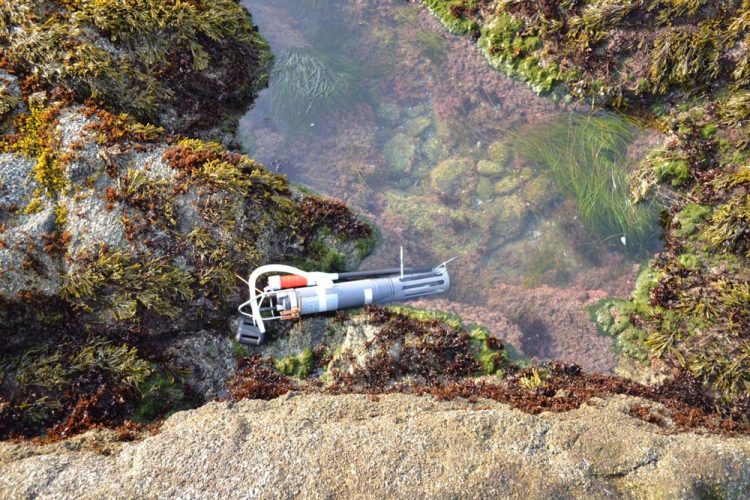Ocean acidification takes a toll on California's coastline at nighttime

This image shows sampling pump and a device to measure temperature, salinity and depth in a tide pool of the UC Bodega Marine Reserve. Photo credit: Lester Kwiatkowski
When carbon dioxide emissions from cars or power plants are absorbed by the oceans, it changes seawater chemistry and makes it more acidic, a process called “ocean acidification.” Increasing ocean acidity makes it difficult for organisms that construct their shells and exoskeletons out of calcium carbonate, such as mussels and oysters, to continue to build these protective layers. In high enough concentrations, carbon dioxide can even cause these shells and skeletons to dissolve entirely.
Tide pools along California's rocky coast are isolated from the open ocean during low tides. During the daytime, photosynthesis–the mechanism by which plants convert the Sun's energy and atmospheric carbon dioxide into sugar, giving off oxygen in the process–takes up carbon dioxide from the seawater and acts to reverse ocean acidification's effects. However, at night, plants and animals respire just like we do, taking up oxygen and releasing carbon dioxide. This adds carbon dioxide to the seawater and exacerbates effects of ocean acidification, causing the increasing risk to calcifying organisms.
Observing a variety of California's natural rocky tide pools on the UC Bodega Marine Laboratory, the authors found that the rate of shell and skeletal growth was not greatly affected by seawater chemistry in the daytime. However, during low tide at night, water in the tide pools became corrosive to calcium carbonate shells and skeletons. The study found evidence that the rate at which these shells and skeletons dissolved during these nighttime periods was greatly affected by seawater chemistry.
“Unless carbon dioxide emissions are rapidly curtailed, we expect ocean acidification to continue to lower the pH of seawater,” said Kwiatkowski, the study's lead author. “This work highlights that even in today's temperate coastal oceans, calcifying species, such as mussels and coralline algae, can dissolve during the night due to the more-acidic conditions caused by community respiration.”
Caldeira added: “If what we see happening along California's coast today is indicative of what will continue in the coming decades, by the year 2050 there will likely be twice as much nighttime dissolution as there is today. Nobody really knows how our coastal ecosystems will respond to these corrosive waters, but it certainly won't be well.”
###
Their paper is a collaborative effort by the Carnegie Institution for Science, the University of California Davis and the University of California Santa Cruz.
A set of photos showing this research is available here: http://dge.
This work was funded by the Carnegie Institution for Science, UC Multi-campus Research Initiatives and Programs, and the National Science Foundation.
Media Contact
All latest news from the category: Earth Sciences
Earth Sciences (also referred to as Geosciences), which deals with basic issues surrounding our planet, plays a vital role in the area of energy and raw materials supply.
Earth Sciences comprises subjects such as geology, geography, geological informatics, paleontology, mineralogy, petrography, crystallography, geophysics, geodesy, glaciology, cartography, photogrammetry, meteorology and seismology, early-warning systems, earthquake research and polar research.
Newest articles

Pinpointing hydrogen isotopes in titanium hydride nanofilms
Although it is the smallest and lightest atom, hydrogen can have a big impact by infiltrating other materials and affecting their properties, such as superconductivity and metal-insulator-transitions. Now, researchers from…

A new way of entangling light and sound
For a wide variety of emerging quantum technologies, such as secure quantum communications and quantum computing, quantum entanglement is a prerequisite. Scientists at the Max-Planck-Institute for the Science of Light…

Telescope for NASA’s Roman Mission complete, delivered to Goddard
NASA’s Nancy Grace Roman Space Telescope is one giant step closer to unlocking the mysteries of the universe. The mission has now received its final major delivery: the Optical Telescope…



